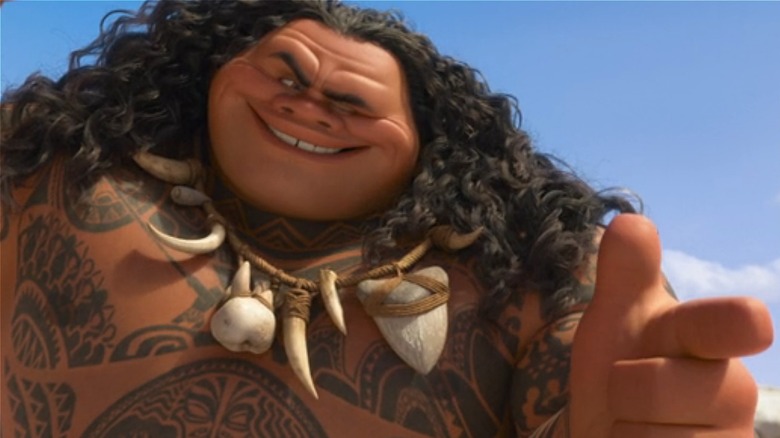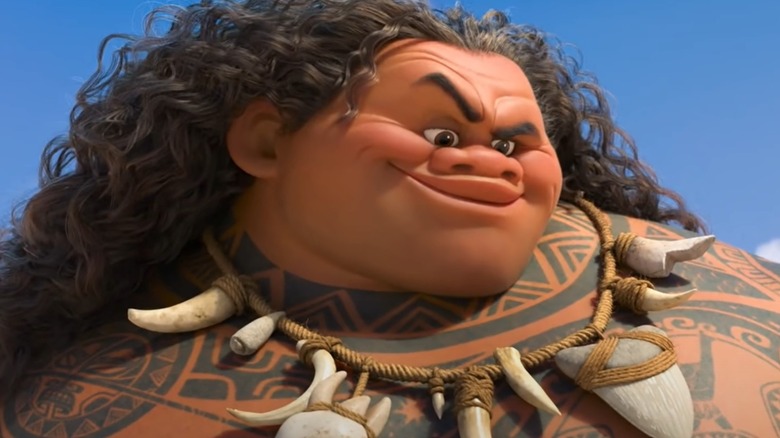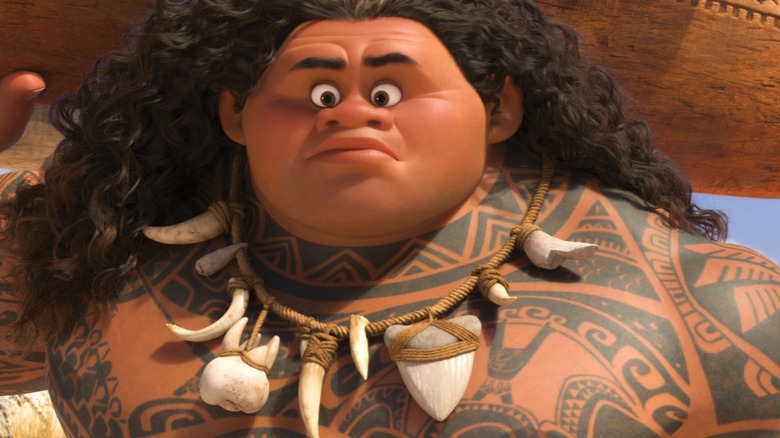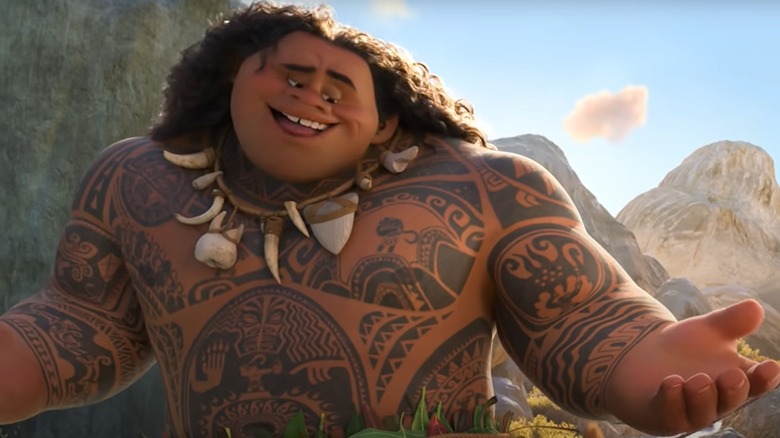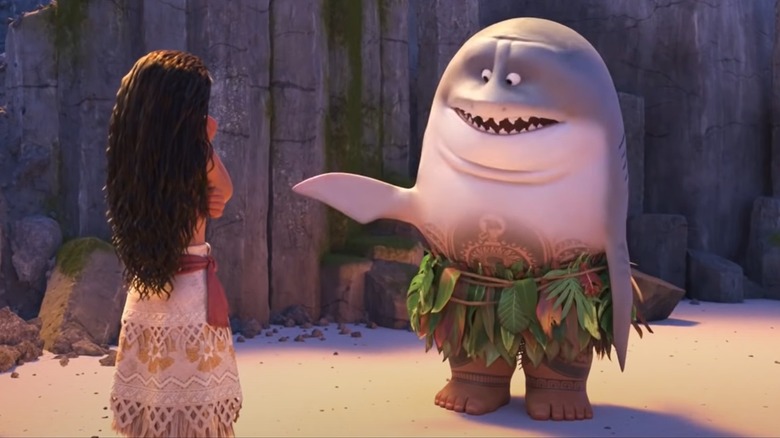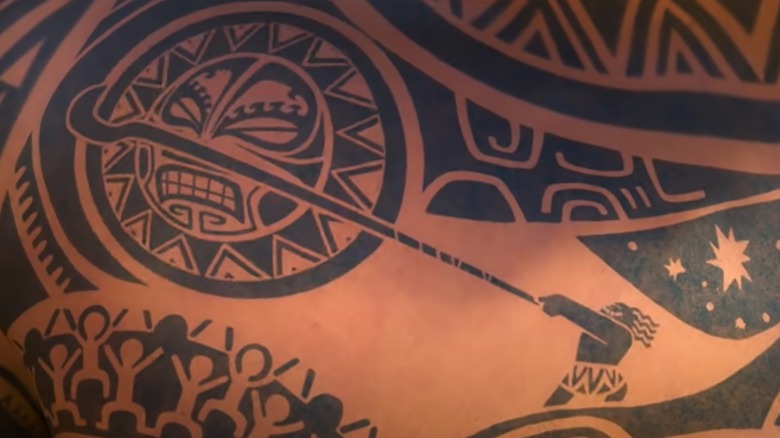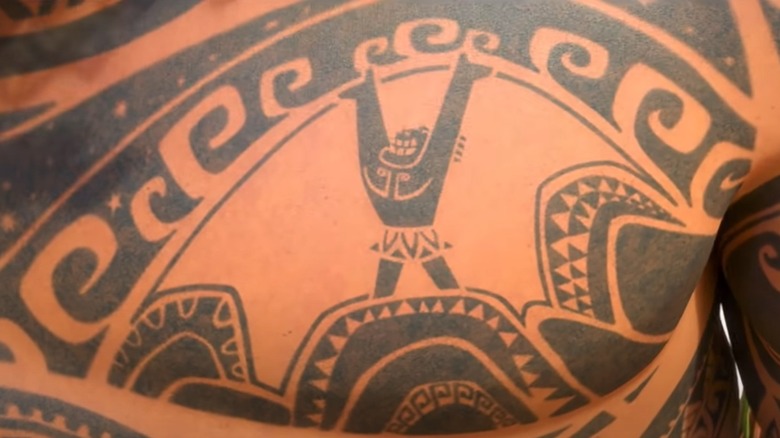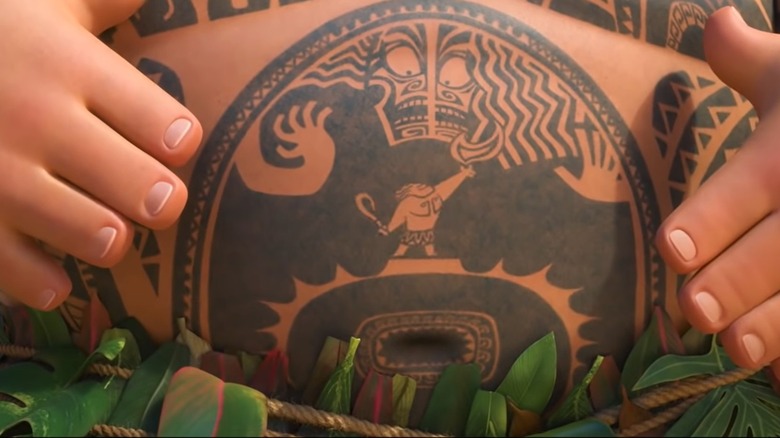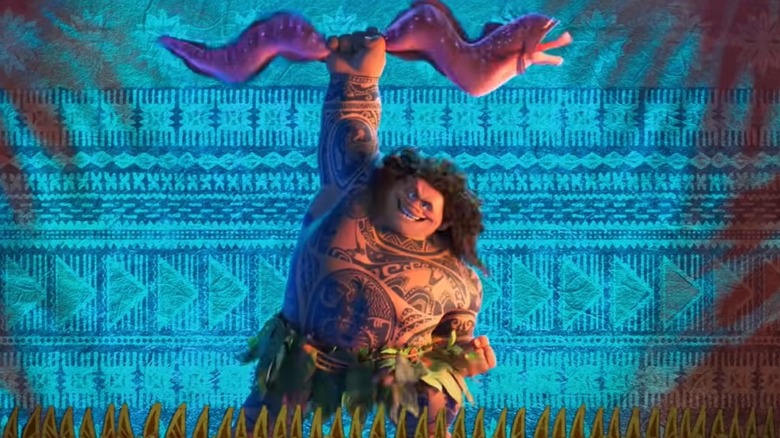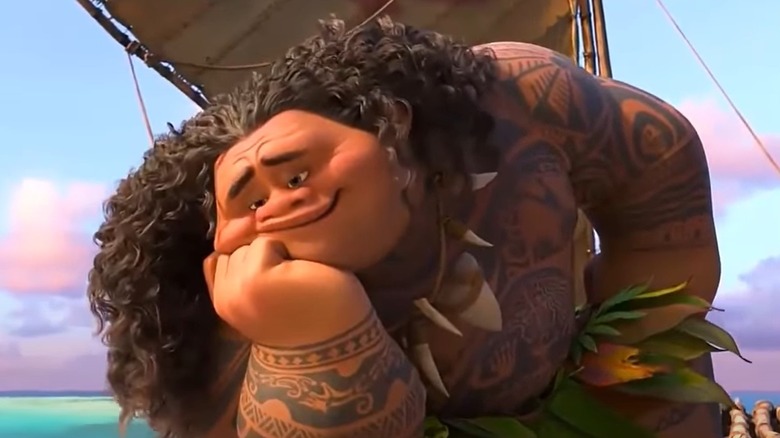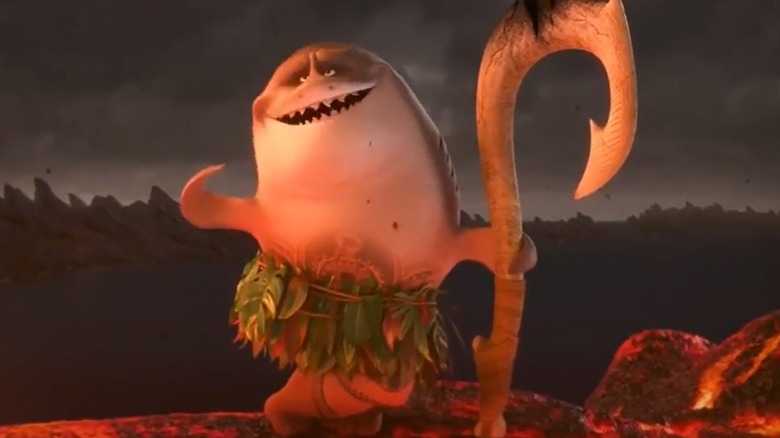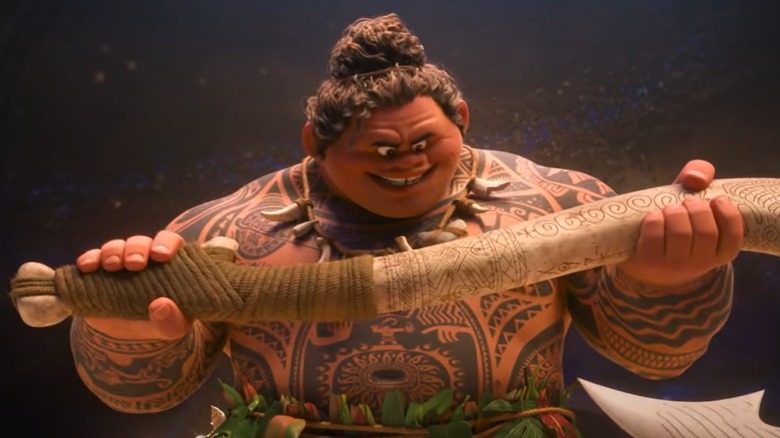What You Probably Didn't Know About Moana's Maui
Disney's "Moana" tells the story of a young Polynesian girl who sets out on a quest to save her family when a blight threatens the island she calls home. Her adventure brings her to Maui, a powerful demigod whose rebellious actions prior to the story have helped bring about the blight and attracted the wrath of a vengeful god that could destroy them both. Like so many Disney animated classics, "Moana" is a musical, featuring songs written by "Hamilton" creator and "Tick, Tick...Boom" director Lin-Manuel Miranda.
While Moana is the title character, Maui (voiced by Dwayne Johnson) is the scene stealer of the film. Every element of the movie is inspired by real Polynesian culture, and Maui is no exception. The mythology of Maui is long and extensive, and includes several different events that the 2016 film doesn't have time to get into, including various stories and interpretations that have evolved over time. Of course, this is common for many animated Disney movies based on folklore or fairy tales, as the filmmakers have taken creative liberties with changing these established stories.
Here are some facts that you probably didn't know about Maui, including some of the legendary feats that he accomplished, what other characters existed in his life, and whether or not the demigod triumphed over all others.
Maui created the Hawaiian Islands on a fishing trip
The Maui who we meet in "Moana" is introduced as a cocky (and very unhelpful) demigod whose selfish actions have doomed the world and who is too reluctant to fix them. He even sings an entire song titled "You're Welcome," celebrating himself and his many accomplishments, which are displayed on several of the tattoos covering his body. As he brashly explains to Moana, Maui was able to accomplish these feats thanks to his godlike powers. In addition to being super strong, Maui also has the ability to shapeshift into various animals.
True to what we see in the movie, Polynesian mythology describes Maui as a trickster who possesses superhuman strength. Though the exact nature of his powers and exactly how he got them tend to change depending on who is telling the story, Maui is so strong that he's able to create entire islands by himself. According to the Polynesian Cultural Center, when Maui was on a fishing trip, his fishhook latched onto the ground by accident, and he believed that he had caught a giant fish that was lurking in the deep. This resulted in Maui pulling up the several giant "fish," which would later become known as the islands of Hawaii, up from the ocean and bringing them together into the formation they're in today.
Maui isn't just a figure of Hawaiian culture
Polynesian culture encompasses a lot of different areas, and as such, the story of Maui tends to change depending on who is telling it. The story of Maui creating the islands is a big part of Hawaiian culture, but the story is slightly different according to Māori mythology. In the Māori version retold at New Zealand's tourism page, Maui followed his brothers after they decided not to take him on a fishing trip. After revealing himself, he cast his fish hook made from an ancestor's jawbone out into the ocean, where it latched onto something big. Thinking it was a fish, Maui pulled up the land and created what is known as the North Island of New Zealand.
You can also find some version of Maui in Tongan, Samoan, Tahitian, and Mangareva mythology as well. Just like the others, little details about Maui change between retellings. Samoan mythology even refers to Maui as Tiʻitiʻi, a completely different name but with similar stories. Though the Disney character is clearly inspired by a blend of multiple interpretations, it appears mostly taken specifics from the Hawaiian and Māori variations.
Maui searched for his family after he was born
The "Moana" version of Maui tries to do good things for all of humanity. After being abandoned by his family when he was a baby, Maui was saved by the gods and granted the special powers of strength, shapeshifting, and immortality that we see in the film. He also wields the power of a magic fish hook. Despite the many great things that he has done (including several things that will be discussed later in this list), Maui would become reviled for stealing the heart of Te Fiti, creating the lava demon Te Ka, and plunging most of the world into darkness.
The part of Maui's backstory that finds him cast out and narrowly avoiding death lines up with the Māori version of the story (via LongLongTimeAgo). However, the film does leave out how the waves formed him after his premature birth and carried him until he was found by his grandfather, Tama-nui-ki-te-Rangi. When Maui was grown, he left his grandfather and set out on a quest to find the rest of his family, leading to a reunion with his brothers and a confrontation with the mother who cast him aside.
In Māori tradition, Maui's parents are named Taranga and Makeatutara, while the Hawaiian version casts him as the son of Akalana and Hina, the latter being a goddess commonly associated with the moon.
Maui usually has siblings who aren't in the movie
The legends regarding the formation of the Hawaiian Islands and the North Island of New Zealand both involve a fishing trip with Maui's brothers. The Disney character doesn't appear to have any siblings, and his parents don't make an appearance at all. But Maui's family has always played a big role in his history.
Depending on who is telling the story, Maui has several brothers (usually four) who go by various names. The Māori version also gives him a sister named Hina (ironically, the name of his mother in Hawaiian mythology). But no matter the variables, Maui's relationship with his siblings always seemed to be strained — staying true to his trickster persona, he's always looking for ways to get back at his siblings whenever he feels slighted, which leads to many of the stories of creation around Maui.
Though Maui's siblings don't appear on screen in "Moana," an interesting behind-the-scenes fact about the film is that, according to an article on the film from USA Today, Moana was supposed to have six siblings, depicted in early concept art. It's interesting how these changes during the movie's development mirror the variations on the legend, but co-director John Musker explained, the extra siblings were cut from the film in order to simplify the story. "Like many things about animated films," Musker told USA Today, "the story just keeps evolving."
Maui didn't just stop the sun from moving, he battled it
There are several moments throughout "Moana" when Maui gets to display his impressive physical strength, including his battle with the demonic Te Ka. The legends of Maui go even further, telling the story of how the demigod was able to take the sun into his own hands. The closest thing "Moana" gets to explaining this story is a small mention in the lyrics of "You're Welcome," but there's more to the story than that.
As retold by Skyline Hawaii, the Hawaiian legend states that Maui's mother Hina was sad because the days were too short to properly dry her clothes. Determined to slow the sun down despite his mother's warnings, Maui fashioned a long rope and used it to lasso the sun in place. After being tied down, Maui explained the situation to the sun, and they agreed to make the days longer.
The Māori version of the legend, which you can find on the Maunga Hikurangi homepage, plays out a little differently. Maui's determination to slow down the sun leaves out any emotional connection with his mother. And while the long rope still remains in the story, a battle between Maui and the sun leads to the demigod physically striking the sun and forcing it to slow down.
He wasn't the only one able to lift up the sky
Another amazing feat that Maui brags about in the lyrics of "You're Welcome" is that he was able to pull up the sky with his bare hands. In a retelling courtesy of Maui Kayak Adventures, the heavens were too close to the physical world, causing serious havoc to plant life on the Earth and forcing people to crawl in order to get around. Not happy with this, Maui decided to visit a priest and an old woman to increase his strength, giving him the opportunity to push the sky up past the mountains, allowing all life on Earth the ability to live normal lives.
Like many legends regarding Maui, this story tends to change between cultures. The website Sacred Texts refers to minor changes such as using his legs instead of his arms, while some legend recast figures other than Maui as the one who does the lifting. Various other gods and goddesses have taken up that role, using either their hands or long poles, and even some plants and animals, like serpents, have shown great strength in lifting up the heavens.
Considering how big movie Maui's ego is when we first meet him early in "Moana," he would not be happy to hear about a serpent taking the credit for his accomplishments.
Maui stole fire, but he also learned it from birds
One important myth referenced in the lyrics of "You're Welcome" is the story of Maui bringing fire into the world. The Māori legend, which you can read via Te Kete Ipurangi, details how Maui's curiosity as to where fire came from led him to extinguish all the fires in his village. To help the villagers, he set out to ask the goddess of fire, Mahuika, to give them more fire. Although Maui was friendly to the goddess and she even offered to help him, Maui later decided to extinguish all of Mahuika's flames out of curiosity. An enraged Mahuika tried to kill Maui, but his prayers to the gods saved him. Maui later returned to teach his people how to make fire by rubbing sticks together.
While the Māori version deals with confronting the gods, the Hawaiian version (via North Shore Eco Tours) is a bit tamer. Since people already got their fire from lands of volcanic activity, Maui and his brothers decided to capture a highly intelligent bird that had discovered how to make fire with sticks. Learning this technique allowed Maui and his brothers to bring fire to their people without having to hike up volcanic mountains. A slightly less thrilling adventure narrative, but an important legend nonetheless.
Hina (and Sina) and The Eel: The creation of the coconut tree
"I killed an eel, I buried its guts, sprouted a tree, now you got coconuts," Maui sings in "You're Welcome." This is a reference to an old story that took place after Maui had lifted up the Hawaiian Islands (via Sacred Texts). After settling down with his Maui as his wife, Hina (a different woman from the previous wife/sister characters) had an encounter with an eel named Tuna-Roa. After the eel attacked Hina, Maui decided to retaliate by killing the eel (the exact way Maui killed the eel has changed over time).
An extremely similar story also appears in Samoan mythology, commonly referred to as "Sina and the Eel" (via the National Park of American Samoa). A beautiful woman named Sina caught the eye of Tui Fiti, the king of Fiji. In order to be with her, he transformed into an eel (sometimes referred to as a tuna) and Sina adopted it as her pet. Their relationship eventually turned sour as the eel grew bigger and older, getting to the point where Tui Fiti had to reveal himself and explain that he could not turn back into a human. After Tui Fiti died, his head was cut off and buried into the ground, resulting in the growth of the first coconut tree.
Interestingly, Moana's mother in the film is also named Sina, and there's a scene in which she harvests coconuts.
Maui and Irawaru, and the creation of the first dog
There are several animals that play various roles in "Moana." There are big ones like Tamatoa, a giant coconut crab that resides in the dark realm of Lalotai, and small ones like HeiHei, Moana's pet rooster that unwittingly gets dragged on her adventure. It's a shame that no dogs appear in the film, as Maui's Māori history features a very tense interaction that legend says led to the creation of the very first dog.
As chronicled by Sacred Texts, Maui's sister Hina ended up marrying a man named Irawaru. Although the two did get along, they would eventually come into conflict with each other. The reason for the conflict varies by the telling, but usually it has to do with the two fighting over fishing. This conflict would result in Maui using his magic powers to turn Irawaru into a dog.
Needless to say, Hina was not happy about seeing her brother turn her husband into an animal, and some legends even say that Hina was so upset that she threw herself into the ocean and was never seen again. A very dark end to an important figure in Maui's life, and something that the Disney film (perhaps wisely) chooses to ignore.
Maui may be a demigod, but is he still able to die?
The ending of movie sees Maui, in the form of a hawk, joining Moana and her people on a fishing voyage. It's a happy ending for a character that, according to another Māori myth, had a very tragic end. This involves Maui's interactions with Hine-nui-te-pō, the Māori goddess of death. As chronicled in "Legends of the Māori" (via The Victoria University of Wellington Library), Maui was told by his own father that in order for him to achieve the immortality he wanted, he would have to confront the goddess herself and kill her.
Maui tried to do so by crawling into the goddess from her lower half and coming out through her mouth while she was asleep. Maui's plan would have worked had it not been for one of his fantail birds awakening the goddess. Realizing what was happening to her, Hine-nui-te-pō closed her thighs and killed Maui.
It's a graphic and violent end to a legendary character, and definitely something those younger viewers of a Disney film would be better off not seeing. That said, should Disney eventually make a sequel to "Moana," it's not entirely out of the question that we could see a more "child-friendly" version of this story play out, leading to another epic battle similar to Maui vs. Te Ka.
The Symbolism Behind Maui's Fish Hook Weapon
Maui's signature weapon throughout the movie is his trusty fish hook. In both the movie and the legends that inspired the character, the hook was given to Maui as a child, and he uses it to accomplish many of his mythic deeds. This weapon not only helps Maui take on various monsters, but it's also the source of his shapeshifting ability. The fish hook is also covered in various markings to represent its many adventures, similar to Maui's own tattoos. Maui's fish hook has even been referenced in other Disney media, including a brief appearance on the ABC fantasy series "Once Upon a Time."
Referred to as a "makau," this particular fish hook in Polynesian culture is meant to symbolize good fortune and safe passage over water (via OluKai). Since Maui uses a similar hook to raise the islands out of the water, the design is also symbolic of how connected the Polynesian people are to the sea. These types of connections are a big part of "Moana," as the ocean acts like a sentient being that reacts to Maui and Moana's presence, usually resulting in small comedic moments of the characters getting drenched.
